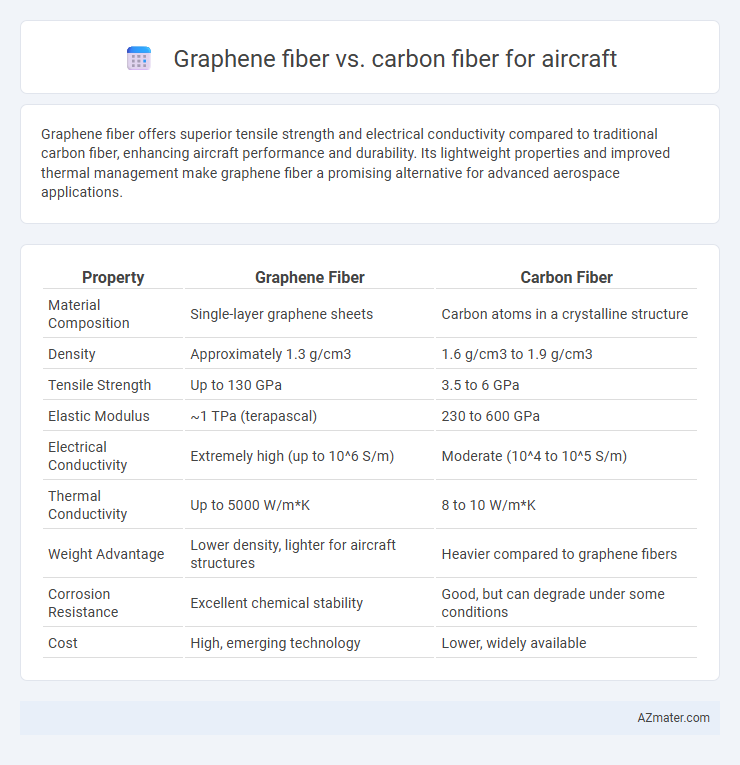Graphene fiber offers superior tensile strength and electrical conductivity compared to traditional carbon fiber, enhancing aircraft performance and durability. Its lightweight properties and improved thermal management make graphene fiber a promising alternative for advanced aerospace applications.
Table of Comparison
| Property | Graphene Fiber | Carbon Fiber |
|---|---|---|
| Material Composition | Single-layer graphene sheets | Carbon atoms in a crystalline structure |
| Density | Approximately 1.3 g/cm3 | 1.6 g/cm3 to 1.9 g/cm3 |
| Tensile Strength | Up to 130 GPa | 3.5 to 6 GPa |
| Elastic Modulus | ~1 TPa (terapascal) | 230 to 600 GPa |
| Electrical Conductivity | Extremely high (up to 10^6 S/m) | Moderate (10^4 to 10^5 S/m) |
| Thermal Conductivity | Up to 5000 W/m*K | 8 to 10 W/m*K |
| Weight Advantage | Lower density, lighter for aircraft structures | Heavier compared to graphene fibers |
| Corrosion Resistance | Excellent chemical stability | Good, but can degrade under some conditions |
| Cost | High, emerging technology | Lower, widely available |
Introduction to Advanced Aerospace Materials
Graphene fiber offers exceptional tensile strength, electrical conductivity, and lightweight properties, surpassing traditional carbon fiber in terms of flexibility and durability for aerospace applications. Its atomic-scale structure enables enhanced thermal management and electromagnetic interference shielding, critical for advanced aircraft systems. Carbon fiber remains widely used due to its established manufacturing processes and high stiffness-to-weight ratio, but graphene fiber's emerging capabilities position it as a revolutionary material for next-generation aerospace engineering.
What is Graphene Fiber?
Graphene fiber is a revolutionary material composed of one-atom-thick layers of carbon atoms arranged in a hexagonal lattice, offering exceptional strength, electrical conductivity, and flexibility. Unlike traditional carbon fiber, graphene fiber exhibits higher tensile strength and improved thermal conductivity, making it ideal for lightweight and durable aircraft components. Its potential to enhance fuel efficiency and structural performance positions graphene fiber as a promising alternative in aerospace manufacturing.
Understanding Carbon Fiber
Carbon fiber is a widely used composite material in aircraft manufacturing due to its exceptional strength-to-weight ratio, corrosion resistance, and high tensile strength, making it ideal for structural components and fuselage panels. Its ability to withstand extreme stress and temperature variations without significant deformation contributes to improved fuel efficiency and overall aircraft performance. Compared to graphene fiber, carbon fiber is more established with proven manufacturing processes and cost-efficiency, though graphene offers potential future enhancements in elasticity and conductivity.
Mechanical Properties Comparison
Graphene fiber exhibits superior tensile strength and elasticity compared to carbon fiber, with tensile strengths reaching up to 130 GPa and elastic modulus around 1 TPa, surpassing carbon fiber's typical 3.5-7 GPa tensile strength and 230-600 GPa modulus. The enhanced mechanical properties of graphene fibers contribute to greater weight reduction and improved fatigue resistance in aircraft applications. Carbon fiber remains widely used due to its established performance and cost-effectiveness, though ongoing research into graphene fiber aims to further revolutionize aerospace material performance.
Weight and Strength Analysis
Graphene fiber exhibits superior tensile strength and a density significantly lower than carbon fiber, making it an emerging material for weight-critical aircraft components. While carbon fiber typically has a tensile strength of around 3,500 MPa and a density of 1.75 g/cm3, graphene fibers can achieve strengths exceeding 6,000 MPa at approximately 1.3 g/cm3. This strength-to-weight advantage positions graphene fiber as a potential material for enhancing aircraft structural performance and fuel efficiency.
Flexibility and Durability Factors
Graphene fiber exhibits superior flexibility compared to carbon fiber due to its atomic-scale thinness and exceptional tensile strength, making it highly adaptable for complex aircraft structures. In terms of durability, graphene fibers resist fatigue and environmental degradation more effectively, enhancing aircraft lifespan under cyclic stress and varying atmospheric conditions. Carbon fiber remains widely used for its established performance and cost-effectiveness, but graphene fiber offers promising advancements in both flexibility and long-term durability for next-generation aerospace applications.
Electrical and Thermal Conductivity Differences
Graphene fiber exhibits significantly higher electrical conductivity than carbon fiber, facilitating enhanced electromagnetic interference shielding and improved lightning strike protection in aircraft applications. Thermal conductivity of graphene fiber surpasses that of carbon fiber, enabling more efficient heat dissipation and temperature regulation within aircraft structures. These properties make graphene fiber a promising material for next-generation aerospace components requiring superior conductivity and thermal management.
Manufacturing Processes and Scalability
Graphene fiber manufacturing involves chemical vapor deposition and wet spinning techniques, offering potential for lightweight, high-strength materials but currently faces challenges in large-scale production due to cost and process complexity. Carbon fiber production relies on established PAN or pitch-based precursors with well-optimized oxidation, carbonization, and surface treatment steps that enable efficient, high-volume manufacturing for aerospace applications. Scalability of carbon fiber is superior, supported by mature industrial infrastructure, while graphene fiber's scalability is limited as researchers focus on enhancing yield, uniformity, and integration into composite structures suitable for aircraft manufacturing.
Cost Considerations and Economic Impact
Graphene fiber offers exceptional strength-to-weight ratio and electrical conductivity, but its production costs remain significantly higher than those of established carbon fiber materials, influencing initial investment decisions in aircraft manufacturing. Carbon fiber, widely used in aerospace, provides a proven balance of cost efficiency and performance, enabling large-scale adoption while keeping overall production expenses manageable. The economic impact of integrating graphene fiber depends on advancements in scalable manufacturing techniques that could reduce costs and optimize long-term benefits such as fuel savings and maintenance reduction.
Future Prospects in Aircraft Design
Graphene fiber offers superior strength-to-weight ratio and enhanced electrical conductivity compared to traditional carbon fiber, promising significant advancements in aircraft structural efficiency and multifunctionality. Its potential for improved damage tolerance and thermal management can revolutionize composite materials used in aerospace, enabling lighter, stronger, and more resilient airframes. Ongoing research into scalable production techniques and hybrid composites indicates graphene fiber may become a cornerstone in next-generation aircraft design, optimizing performance and fuel efficiency.

Infographic: Graphene fiber vs Carbon fiber for Aircraft
 azmater.com
azmater.com